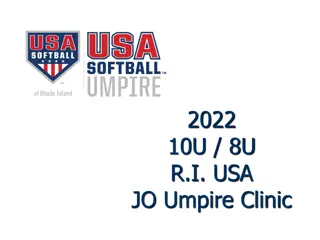Plate Umpire: Mastering the Art of Calling Strikes and Balls
Plate umpiring is a challenging role that demands focus, decision-making, and proper positioning. From the standing position to strike zone philosophy, this guide covers key techniques like set position fundamentals, pitch tracking, and signaling calls for balls and strikes. It emphasizes the importance of confidence and accuracy in officiating baseball games, offering valuable insights for aspiring umpires.
Download Presentation

Please find below an Image/Link to download the presentation.
The content on the website is provided AS IS for your information and personal use only. It may not be sold, licensed, or shared on other websites without obtaining consent from the author.If you encounter any issues during the download, it is possible that the publisher has removed the file from their server.
You are allowed to download the files provided on this website for personal or commercial use, subject to the condition that they are used lawfully. All files are the property of their respective owners.
The content on the website is provided AS IS for your information and personal use only. It may not be sold, licensed, or shared on other websites without obtaining consent from the author.
E N D
Presentation Transcript
Plate Umpire: The plate assignment is one of the hardest jobs in sports officiating. It normally requires more than 200 decisions in a two hour period. It requires a great deal of concentration and common sense. Standing Position - The standing position places our feet and bodies in the general location needed for calling the strike zone properly except for the fact PU is still standing. Set Position Watch as F1 begins his motion, then drop to a set position. Use your legs to adjust your head height and lean forward only enough to keep your balance.
Plate Umpire: Set Position Fundamentals Your eyes should be 3 to 6 inches inside of the plate. Set your eyes about a ball width higher than the top of the batter s upper strike zone. Chin should not be below the catcher s head. Lock your elbows into your body. Pitch tracking Follow the pitch with your eyes not your head. See the ball from pitcher s release through the catchers mitt. Evaluation Allow time to perceive, process and evaluate all input before making a call.
https://www.littleleague.org/university/article s/plate-mechanics-explaining-slot/
Plate Umpire: Signal and Call If the pitch is a ball, remain in the set position and say Ball . The distance from the zone will dictate how loudly you call the ball If it is a borderline (close) pitch, then yell out Ball as loud as you say strike in order to sell the call. If it is in the dirt or obviously out of the zone, then a soft Ball or no call at all is acceptable because everyone knows the pitch is a ball. If the pitch is a strike, then stand up, step back and simultaneously do the strike mechanic and say Strike Remember, all called strikes must be sold because you are increasing the batter s difficulty in battling the pitcher. If the pitch is swung and missed, give the strike mechanic without voice - Everyone in the park can see the batter has swung at the pitch.
https://www.littleleague.org/university/article s/called-ball-mechanic/ https://www.littleleague.org/university/article s/swinging-strike-mechanic/ https://www.littleleague.org/university/article s/called-strike-mechanic/
Plate Umpire: Strike Zone Philosophy New Umpires tend to: Believe the rule book dictates the strike zone for all levels of play Believes in literal interpretation of the strike zone Ball a pitch that misses the zone by the slightest distance Ball a pitch that s marginal when unsure Lack confidence in their officiating These characteristics lead to fewer strikes, fewer swings and fewer bat-ball contacts, miring games in long counts and walks. Instead ..
Plate Umpire: Strike Zone Philosophy Calling the zone is not an exact science Youngsters don t possess the arm strength nor accuracy of professional ballplayers. Think strikes! Assume strikes until proven a ball. The strike zone provides the balance between offense and defense. On questionable (marginal) pitches, give the benefit of the doubt to the pitcher. Aggressive strike zones keep teams focused on hitting, fielding and pitching (not walking).
https://www.littleleague.org/university/article s/hands-knees-set-position/
https://www.littleleague.org/university/article s/out-mechanic/ https://www.littleleague.org/university/article s/set-safe-mechanic/
https://www.littleleague.org/university/article s/a-position-no-runners-on/ https://www.littleleague.org/university/article s/a-position-the-pivot-migration/ https://www.littleleague.org/university/article s/the-b-position-runner-on-first-base/ https://www.littleleague.org/univ ersity/articles/c-position-runner- on-second-third-or-bases-full/























